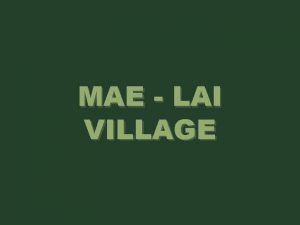MAE LAI VILLAGE Introduction To get more information



















- Slides: 19

MAE - LAI VILLAGE

Introduction • To get more information about the people who live in this area and their way of life, we have decided to visit Mae-Lai Village, which is one of the eight villages that composed Huay-Kaew Sub-District. • 55 families live in Mae-Lai. In total, 164 people are part of this community. 20 children are under 15 years old. • We are going to see how they live and what their occupations are.

Villagers Way of Life • The villagers live in wooden houses. • A majority of them earn their living in agriculture. They work almost every day in the fields. • Most of the families are composed by 2 to 4 people, with two people working to feed the whole family. • Their monthly income is approximately 5000 - 7000 Baths per family.

Villagers Way of Life • All the members of the community have really strong relationships and help each other a lot – If someone needs food, the othere to help out. – They also barter their products and services for others they may need. • They constitute a self-sufficient community in the sense they: – Grow their own vegetables – Raise chickens – Can pick fruits from the commons.

Villagers Way of Life • • When a day of hard work is finished, the villagers are really tired and usually stay home with their family. Some of them gather for a chat and share their experience. The ones who have children go to pick them up at the local school. Once back from school, children do their home work. They also are used to playing with their friends. Young boys enjoys playing soccer. One 12 year old girl, Or, told us that when she is back from school, she has to do her homework and take care about her 2 younger brothers.

Villagers Way of Life When they are not tending to their fields, they spend time. . . cultivating vegetables in their private gardens. taking care of their chickens. picking fruits in the forest. checking on the tea fermentation process. taking their products to the sales person. and of course, have some rest!!

Villagers Activities • The main part of the villagers' life is dedicated to work. • We are going to see that there are two main activities that can bring them a significant income: – TEA – COFFEE They also expecting a lot about the ecotourism project. • First of all, we will explain the reason why tea is so important in this area and the different process of the production. • Second of all, we will how come the coffee cultivation in the village and its benefits. • Then, we will shortly talk about the nature trail project.

Villagers Activities - Tea • Actually, the village was set up at this place more than 100 years ago because the surrounding forest was, and still is, suitable for tea planting. • The main activity in this area is the Tea crop. 48 of 55 families work in tea fermentation. • The main product is “Cha-Miang” which means “pickle tea leaves” in English. It is a traditional food in Northern Thailand, but not very common any more. So, the life of the villagers is directly linked to the tea cultivation

Villagers Activities - Tea • Every family own its private piece of land to cultivate the tea so, every family earns its own income. • Tea at its natural state is about 6 Baths per kilo. For example, this girl has collected 10. 5 kg while working from 8. 00 am to 5. 15 pm. She will get only 63 Baths for a whole day of work!!

Villagers Activities - Tea • Tea can be picked six months a year, from May to October. • From January to May, the villagers clean and prepare the fields for the harvest. They also cut some wood to stock for the year. • There are different steps in the preparation of the Pickled Tea Leaves The first step is PICKING

Villagers Activities - Tea • Back from the fields, the villagers go home to have a shower. But, the working day is not finished yet. While the women are cooking dinner for the family, the men have to steam the tea leaves. • First, they have to set up a fire in the kiln. • They have to tightly tie the leaves with bamboo ropes, and put them in a big pot. Then, put them on the fire with clean water and let them steam for one hour. The Second step is STEAMING

Villagers Activities - Tea • Even during the steaming process, there is much solidarity between the villagers. If the steamer is not full of Tea Leaves, another family can come and add its products in the steamer, if they provide some wood to feed the fire. • The two families' harvests are separated by a net. The Second step is STEAMING

Villagers Activities - Tea • After steaming is time to process the leaves for fermentation. • The steamed leaves are placed in a circle in a big stone pot and covered by plastic. • Then, the pot is covered so that air cannot come inside. • The Pickled Tea Leaves will be ready in one month • But, they can be kept for 1 or 2 years if well protected from the air and sun, and are properly hydrated with purified water. The Last step is FERMENTATION

Villagers Activities - Tea • Once Cha-Miang is ready, villagers need to sell the products. • Usually, they do not go to the market by themselves to sell the Pickled Tea Leaves. Many of them do not have cars, just bikes. Moreover, the market is located very far away from their houses. It would cost them too much in gas expenses. So, sales persons come directly to the village to buy individually from each family. The price per bag is fixed to keep the equity between families.

Villagers Activities - Coffee • The community also grows coffee. • The Royal Project, which is set up not far from the village, is in charge of the protection of the flora and fauna. They wanted the villagers to stop cutting the trees and harvesting in these areas. So, they offered support to Mae-Lai by helping it cultivate coffee. Coffee cultivation can respect the environment because it needs shade. This is a cleaver, and very profitable, way to prevent deforestation. It is a WIN-WIN collaboration!

Villagers Activities - Coffee On the Thai market, coffee is a lot more expensive than tea. Dried clean beans can be sold for 90 Baths per kilo • Roasted beans can be sold 200 - 300 Bahts per kilo. However, even though coffee is profitable for the villagers, it cannot be cultivated it all year. Coffee can be harvested only for two months a year, from November to December.

Villagers Activities – Nature Trail • One of Track-of-the-Tiger's projects is to develop ecotourism in this area by: – – – Assist in building and maintaining a Nature trail Identifying and tag the plant life on the trail Reforesting degraded ecosystems with indigenous species 3 or 4 villagers work everyday in the forest to build the trail

Villagers – Expectations • The villagers want their village to stay alive, keep its authenticity and retain its sense of community. They actually would like the next generations to live here and pass down their culture. • However, they also want their children to have a bright future. We have learned through interviews at the local school, that none of them have dreams of being a farmer like their parents. These children all want to keep living in the area to stay with their family and friends because they like this place a lot. • The parents want to continue with the tea and coffee cultivation but they realize that the income that this generates is not enough to feed their children, and moreover it is a very hard job. They are expecting theirs to get good jobs, earn enough money to build their own nice houses and make their families happy.

Villagers Activities – Expectations • The chief of the village told us that he is expecting a lot from the ecotourism project. It would bring a huge revenue from tourist attractions and give jobs to the young population. • The trail belongs to the village community and the villagers would have to keep it safe and clean. Some young people who know the area would become tourist guides. • Tiger-of-the-Track is planning to create a nature trail guide to attract conventional tourists. • The entrance fee to the trekking area is around 250 baths per adult and 150 per child. All the money goes to the village community. For the moment the money they received has been used to send sick people to the Hospital and send children from poor families to school
 Lirik lagu more more more we praise you
Lirik lagu more more more we praise you More more more i want more more more more we praise you
More more more i want more more more more we praise you Mae lai
Mae lai Get on / get off transport
Get on / get off transport Kop chai lai lai
Kop chai lai lai Mai lai massacre 1968
Mai lai massacre 1968 One direction songs with figurative language
One direction songs with figurative language Get up get moving quiz
Get up get moving quiz Get up get moving quiz
Get up get moving quiz Get up get moving quiz
Get up get moving quiz Pseudocode repetition
Pseudocode repetition Get focused get results
Get focused get results Germer
Germer Get more math
Get more math The more we get together the happier we'll be
The more we get together the happier we'll be Leads and enquiries
Leads and enquiries 5 apples in a basket riddle
5 apples in a basket riddle The more you study the more you learn
The more you study the more you learn Aspire not to
Aspire not to Newton's first law of motion
Newton's first law of motion
































